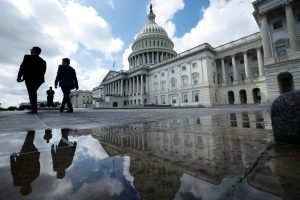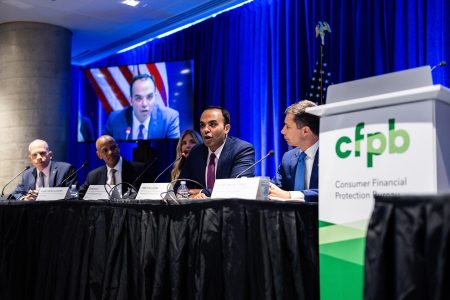Few Americans are making the kind of money they feel they need to live comfortably — and most think it’s unlikely that they ever will.
Just 6 percent of the Americans who have an idea of what they’d need to earn to feel secure say they are already earning that annual income, according to Bankrate’s annual Financial Freedom Survey. About 2 in 5 (37 percent) say it’s likely that they’ll one day earn that income, while 31 percent indicate it’s unlikely and 18 percent think their income will never get to that level in their lifetime.
Those findings come as Americans report for the second year in a row that they need to make a major six-figure salary (over $186,000 a year, on average) just to live comfortably, more than double what the average full-time, year-round worker typically makes (about $79,000, according to the Census Bureau), Bankrate’s polling finds.
Shockingly, most Americans aspire to get to a place where they’re living comfortably or unburdened by financial worries — not to live in a state of financial opulence. These days, financial success looks like living comfortably, being financially prepared for the future and not worrying about money, according to a previous Bankrate poll. Even so, most don’t consider themselves financially successful.
Getting their finances to a steady state can be challenging when the same goods, services and wealth-building opportunities of years past require more income. Prices have risen almost 21 percent since the pandemic, requiring an extra $210 per every $1,000 someone used to spend on the typical consumer basket, Bureau of Labor Statistics data shows. Not to mention, other longer-term challenges from housing to college affordability are at play. Americans now need a six-figure salary to afford a typical home in almost half of U.S. states, and households are feeling that college tuition prices have gotten out of hand, separate Bankrate data indicates.
Many Americans are stuck somewhere between continued sticker shock from elevated prices, a lack of income gains and a feeling that their hopes and dreams are out of touch with their financial capabilities.
— Mark Hamrick, Bankrate Senior Economic Analyst
Key takeaways on Americans’ feelings of financial security in 2024
- Rising feelings of financial insecurity: Just 1 in 4 (25%) Americans say they are completely financially secure, down from 28% in 2023. Whereas 72% of Americans indicated they were not completely financially secure in 2023, that number has now risen to 75% in 2024. Three in 10 (30%) Americans say they are not completely financially secure and likely never will be, up from 26% in 2023.
- The cost of living comfortably: On average, Americans feel they’d need to earn over $186,000 to feel financially secure or comfortable, a 20 percent drop from 2023 but still more than two times what the average full-time, year-round worker earned in 2022 (about $79,000), according to Census Bureau data.
- How much it takes to be rich: To feel rich, the average American feels they need to earn $520,000 a year, an 8 percent increase from $483,000 in 2023.
- Expecting the worst: Slightly more than 1 in 3 who have a vision for the income it takes to live comfortably (37%) say it’s likely they’ll one day earn the annual income they feel they need to be financially secure or comfortable, including 16 percent who say it’s highly likely. That compares with 31% of Americans who say it’s unlikely that they’ll ever make their desired income, including 17% who say it’s highly unlikely. About 1 in 5 (18%) who say they never will.
Fewer Americans than last year are feeling financially secure
The feeling of having insufficient income may be taking a financial toll: About 3 in 4 (75 percent) of Americans say they are not completely financially secure, up from 72 percent in 2023. That share includes 30 percent who say they are not completely financially secure and likely never will be, on the rise from 26 percent a year ago. Another 45 percent expect to be financially secure someday.
Across education levels, income and age, all groups were more likely to currently feel financially insecure than secure. But some groups indicated that they’re in better financial shape than others:
- Americans with postgraduate degrees who say they are completely financially secure: 45 percent; and
- Americans making $100,000 or more: 44 percent.
On the other hand, most groups thought they were more likely to achieve financial security someday. Yet, some groups were more likely to expect that they’ll never achieve it, including:
- Americans making under $50,000: 43%
- Baby boomers (ages 60-78): 42%
- Parents with children aged 18 and older: 39%
In fact, when it comes to income, more Americans earning under $50,000 a year than last year indicate that they are not financially secure and likely never will be (43 percent in 2024 versus 36 percent in 2023), the largest increase of any group.
Of the generations, meanwhile, Generation Z (ages 18-27) was the most likely of any other demographic to feel that they will one day be financially secure. Generation Xers (ages 44-59) were the least likely to feel completely financially secure, and baby boomers were the most likely to feel that they’ll never be financially secure.
| Financial security levels | Gen Z | Millennials (ages 28-43) | Gen X | Baby boomers |
|---|---|---|---|---|
| I am completely financially secure | 24% | 26% | 15% | 32% |
| I am not completely financially secure but will be someday | 64% | 53% | 48% | 26% |
| I am not completely financially secure and likely never will be | 13% | 21% | 37% | 42% |
“We’ve gone from an environment where inflation was the focus, and the impact of rising prices has resulted in an affordability crisis, which is now front and center,” Hamrick says. “If prices continue to normalize and the job market remains stable, further progress can be clawed back on the affordability front.”
-
By region, Americans in the South were the most likely to indicate they are not completely financially secure and likely never will be. Reflecting those feelings of insecurity, the share of Southerners who indicate that they are feeling completely financially secure dropped to 21 percent in 2024 from 31 percent in 2023, while the share of those in the region never expecting to feel financially secure jumped from 24 percent to 35 percent.
Financial security levels South Midwest West Northeast I am completely financially secure 21% 25% 30% 25% I am not completely financially secure but will be someday 43% 43% 45% 50% I am not completely financially secure and likely never will be 35% 32% 25% 25% Broken out by gender, women are more likely than men to feel that they are not completely financially secure and likely never will be. Men, on the other hand, are more likely than women to report that they are completely financially secure.
Financial security levels Men Women I am completely financially secure 27% 23% I am not completely financially secure but will be someday 46% 44% I am not completely financially secure and likely never will be 27% 33% White Americans are the most likely of any other racial group to feel completely financially secure, while Black Americans are the most likely to indicate that they’re not completely financially secure.
Financial security levels White Americans Black Americans Hispanic Americans I am completely financially secure 27% 17% 22% I am not completely financially secure but will be someday 40% 58% 53% I am not completely financially secure and likely never will be 33% 25% 25%
How much money would you need to make to live comfortably? This year, Americans feel they need over $186,000, on average
When it comes to the annual income Americans feel they would need to make to be financially secure or comfortable, Americans were closely divided on whether they need to earn $100,000 or more (43 percent) or are content with making less than $100,000 (46 percent).
A quarter of Americans (25 percent) believe they would need to earn $150,000 or more to feel financially secure, while 7 percent feel they would need to earn $500,000 or more, Bankrate data finds. A smaller 4 percent cited $1 million or more as the annual income they feel they need to make to be comfortable.
Among the 2,400 Americans that Bankrate surveyed, the average income they felt they needed to earn hit $186,000.
Some groups felt they needed to earn even more than the national average to live comfortably, including:
- Men: $197,000;
- Westerners: $205,000;
- Black Americans: $282,000;
- Parents with children younger than 18: $215,000:
- Gen Zers: $200,000;
- Millennials: $199,000; and
- Americans earning $100,000 or more: $246,000.
Living within your means: A guide
Building a budget is an important part of a healthy financial life.
Read more
Perhaps echoing themes of lifestyle inflation, the more money Americans make, the more they feel they need to earn to be financially secure or comfortable:
- Under $50,000: $157,000;
- Between $50,000-79,999: $159,000;
- Between $80,000-$99,999: $177,000; and
- $100,000 or more: $246,000.
Younger generations also believe they’d need to make more to feel comfortable. Gen Zers and millennials had the highest average perceived income needs ($200,000 and $199,999, respectively), while the average income that Gen Xers ($183,000) and baby boomers ($171,000) felt they needed to make were the lowest, Bankrate’s report found.
Black Americans reported feeling that they need to make 65 percent more than White Americans ($282,000 versus $171,000) and 63 percent more than Hispanic Americans ($173,000).
To be rich, Americans feel they need to make more than half a million a year on average
When it comes to the annual income Americans feel they would need to make to be financially free or rich, almost half (49 percent) feel they need to earn $200,000 or more, up from 44 percent in 2023. Meanwhile, a third (33 percent) say they need to make $500,000, an increase from 31 percent. Americans feel they need to make $520,000 on average, up 8 percent from $483,000 in 2023.
All groups, except those who are widowed and Gen Xers, indicated that they need to make more money this year to consider themselves financially free or rich. The biggest increases were among:
- Men (up 16 percent from last year): $538,000;
- Midwesterners (up 15 since 2023): $516,000;
- Black Americans (a 15 percent increase): $621,000;
- Gen Zers (up 21 percent from last year): $461,000;
- Those 74 and up (up 25 percent from last year): $461,000.
The average Black American reportedly needed the highest income of any demographic ($621,000), followed by those earning $100,000 or more a year ($605,000).
Similar to how the salary needed to feel comfortable rises with income, so does the salary needed to feel rich:
- Under $50,000: $445,000;
- Between $50,000-79,999: $532,000;
- Between $80,000-$99,999: $553,000; and
- $100,000 or more: $605,000.
Northeasterners needed the most of any region to feel financially free or rich, eclipsing even those who live in the West:
- Northeast: $554,000
- Midwest: $516,000
- South: $513,000
- West: $511,000
Meanwhile, men need to earn about 7 percent more to feel financially rich than women (at $538,000 versus $503,000), Bankrate’s poll found.
More often than not, Americans think it’s either unlikely or impossible to make the money they say they need to feel secure
Focusing on those who have an idea of what they’d need to earn to feel financially secure, Americans with postgraduate degrees (at 12 percent), baby boomers (13 percent) and those earning between $80,000 to $99,999 (12 percent) and $100,000 or more (12 percent) are the most likely to indicate that they’re already earning the annual income they need to feel comfortable.
On the flip side, 2 percent of parents with children younger than 18 say they are already making the annual income they need to feel comfortable, along with just 3 percent each for Gen Zers, millennials and those making under $50,000.
Men are more likely to think they’ll one day achieve the salary they need to live comfortably (at 41 percent versus 33 percent of women). Women, meanwhile, were most likely to indicate that they’ll never be able to achieve the salary they need to feel comfortable (at 21 percent versus 16 percent of men).
And even though they feel they need to make the most money to live comfortably of any generation, Gen Zers are the most optimistic about being able to earn the salary they need to feel comfortable one day (63 percent), versus 50 percent of millennials, 31 percent of Gen X and 17 percent of baby boomers.
-
While the salary Americans feel they need to make to feel comfortable rises with income, higher-income earners are also the ones most likely to think that they’ll one day be able to earn the salary they need.
Financial security levels Under $50,000 a year Between $50,000 and $79,999 Between $80,000 and $99,999 $100,000 or more Likely 34% 36% 34% 49% Unlikely 31% 32% 37% 26% Never 24% 19% 10% 9% Black Americans were most likely to say it’s highly or somewhat likely that they’ll be able to make the salary they need to be comfortable, while White Americans felt it was more likely that they’ll never be able to achieve the salary they need to live comfortably.
Financial security levels White Americans Black Americans Hispanic Americans Likely 32% 51% 45% Unlikely 33% 23% 30% Never 21% 13% 14%
“The messaging in America typically weighs heavily on the side of a call to action to spend, not so much to save or live beneath one’s means,” Hamrick says. “A result is that all too many Americans fail to save sufficiently for emergencies and retirement. There’s no question that inflation and elevated prices, as well as shifting demands for the cost burdens associated with paying for higher education, health care and retirement, have made it more challenging.”
‘I don’t want to be wealthy. I just want to be comfortable.’
To Shannon Wymore, the chase for financial security has felt like a cycle of perpetual pursuit. Throughout her life, she’s come close to hitting the bar that she’s set for herself — only to find that it’s been moved further away again.
“Once I get to a level of comfortability, it seems like something else happens or something else occurs, to where we’re knocked out of that comfort zone,” she says. “I’ve watched the bar get pushed and pushed, and I’ve just given up on it, knowing that I will never be able to attain what everyone says wealth should be.”
Lately, it’s inflation that’s been raising the standard for her. Wymore, a Gen Xer, says she’s making the salary that she would’ve considered to be her financial comfort number — somewhere between $80,000 to $100,000 — four years ago. Today, however, her utilities have more than doubled, her car insurance costs almost $1,000 a month and she often finds herself burning through what used to be her monthly grocery budget in just a week.
“Nowadays, a lot of people associate comfortableness with being wealthy and those are two totally different things,” she says. “But how do we stop the cycle of inflating our view of comfortability, our perception of what is realistic, when there is inflation?”

Her family of five, including her husband and her 19-, 17- and 15-year-old children, have cut the vacations. She has to take smaller trips to the grocery store to limit upfront costs and fears her two youngest children will have to learn to drive late because she can’t afford to add them to her insurance right now. Thanks to some pandemic-related expenses and emergency repairs, she’s down to about $1,000 in both her emergency fund and 401(k).
Now, Wymore says the salary she feels she needs to make to be comfortable is likely in the ballpark of $100,000 to $125,000. She’s hopeful that she’ll be able to achieve it within the next five years and that the range she needs won’t increase too much, now that inflation is slowing. Yet, she also recognizes that her current goalpost would be considered wealthy — not just comfortable — 40 years ago when she was growing up in the 1980s. A $125,000 salary in May 2024 has the same buying power as $32,557 in May 1980, according to the Bureau of Labor Statistics’ inflation calculator.
U.S. cost of living over time
The annual income Americans feel they need to live comfortably ($186,000) has the same buying power as:
- $48,444 in May 1980;
- $76,516 in May 1990;
- $101,567 in May 2000; and
- $129,211 in May 2010.
The annual income Americans feel they need to be rich ($520,000) has the same buying power as:
- $135,435 in May 1980;
- $213,915 in May 1990;
- $283,950 in May 2000; and
- $361,231 in May 2010.
Source: BLS’ CPI Inflation Calculator
“Where we could live and breathe and have some money in our savings — that’s what I would consider living comfortably,” Wymore says. “I would have money in my savings account. I would have money in my 401(k). I don’t have to worry if I have enough to cover groceries this week or pay my insurance. All the bills would be paid on time. I don’t want to be wealthy. I just want to be comfortable.”
Bottom line
Americans have differing perceptions of how much money it takes to feel financially comfortable and rich, likely driven by lifestyle choices, savings habits and overall feelings of financial security. But desire is different than potential, and every American may have a different career wage projection depending on their specific industry.
- If a high salary is important to you, consider researching what Americans in your desired industry earn. Resources from the Department of Labor can give Americans the insight they need to help inform them of what a realistic salary range could look like.
- Know that you can still take steps toward boosting your financial security, regardless of the income you make. Keep a tight budget, live within your means and make every effort to save at least some amount for both short- and long-term savings goals. A six-figure salary is hardly the path toward financial security for someone who is spending more than they’re making, racking up credit card debt and putting nothing away in accounts that help build wealth, such as investment accounts or high-yield savings accounts.
- Even if you have debt, consider the opportunity cost of paying it down. Don’t sacrifice retirement savings for paying down your mortgage or student loan debt quicker, and even if you have credit card debt, a lack of savings may be one of the reasons you keep racking up a balance. (And remember: Balance transfer cards are an option to help you get out of debt quicker).
- Remember, you’re your own best advocate in your career. Americans should constantly be thinking about negotiating and getting paid what they’re worth. Asking for a raise involves speaking your company’s language. Think about ways you can translate the meaning behind the work that you do and its contributions toward your company’s bottom lines.
“Our culture is one where there is much focus on material possessions, and that does not tend to lend itself to a satisfying life,” Hamrick says. “Overspending on a larger home, a fancy car, or unneeded clothing, consumer electronics, etc. are not part of a winning game plan.”
-
Bankrate commissioned YouGov Plc to conduct the survey. All figures, unless otherwise stated, are from YouGov Plc. The total sample size was 2,407 U.S. adults. Fieldwork was undertaken between May 16-20, 2024. The survey was carried out online and meets rigorous quality standards. It employed a non-probability-based sample using both quotas upfront during collection and then a weighting scheme on the back end designed and proven to provide nationally representative results. The annual incomes Americans feel they need to earn to be both financially secure/comfortable and financially free/rich are rounded to the nearest thousandth.
Read the full article here
















